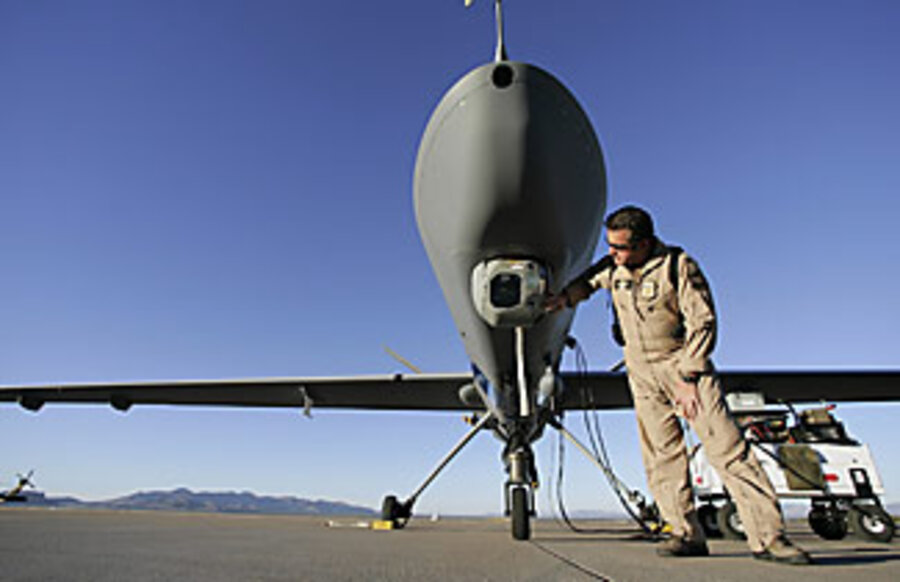In push for drones, Gates labors to change Pentagon
Loading...
| Washington
The military is scrambling to put more unmanned aircraft over Iraq and Afghanistan to conduct surveillance and augment ground forces there.
US troops see the unmanned aerial vehicles – or UAVs – as "force-multipliers," simple and relatively inexpensive ways to boost their effectiveness in the field. But the latest impetus to get them deployed comes from the top. Defense Secretary Robert Gates last week publicly chastised the services for not getting more of the planes into battle zones.
The flap over the unmanned planes is the latest example of Secretary Gates's effort to shake up the Pentagon. Much like his push to speed up delivery of armored troop-transport vehicles to Iraq last year – a request that originally came from the field – the new initiative is part of Gates's strategy to force the services to think differently and more creatively to solve problems quickly, experts say.
But overcoming the Pentagon's institutional inertia will not come easily.
Even as they agree with Gates's assessment that new approaches are needed, officials at the Army and Air Force, which lead the military in the use of unmanned planes, say that they are doing as much as they can.
"It's perfectly logical to me that the Defense secretary is as frustrated as he can be," says Brig. Gen. Blair Hansen, who directs the Air Force Intelligence, Surveillance and Reconnaissance division at the Pentagon. "We need to do all we can to shove as much capability into the field at almost all cost."
At issue is how to provide more and better ground surveillance in Iraq and Afghanistan. Instead of using ground forces to "peek around the corner," unmanned planes flown by remote control can help spot enemy activity or provide surveillance of potential targets more cheaply and safely.
Gates announced last week that he had created a new task force to look at how the military could provide more such planes faster and expects the first report in the coming days.
The US military uses dozens of different kinds of unmanned planes, ranging from small hand-launched craft to much larger ones that can fly at 65,000 feet for many hours.
The unmanned plane most in demand is the Predator, one of a handful of planes flown by the Army and Air Force. On of its crucial abilities is providing full-motion video, which gives commanders on the ground critical information in near real time about the surrounding area.
"There is a black hole of need for full-motion video," says Tom Ehrhard, a senior fellow at the Center for Strategic and Budgetary Assessments, a think tank in Washington. "Why doesn't America have every soldier with full motion-video and a UAV over his head?"
But Mr. Ehrhard and other analysts say military commanders face a host of limitations in using unmanned planes. Bandwidth – which allows them to transmit video – is limited. So is airspace. Military units need specialists trained to fly and maintain the planes – as well as a place to store the UAVs in war zones.
Despite the challenges, Gates is pushing the services to deploy more UAVs.
In the low-key but hard-edged style for which he has become known, Gates delivered speeches last week at two military schools that urged more creative thinking. "My concern is that our services are still not moving aggressively in wartime to provide resources needed now on the battlefield," Gates told officers at the Air War College at Maxwell Air Force Base in Alabama.
Analysts criticize the Army for not keeping as many of the aircraft deployed as possible, saying units return home with their UAVs instead of leaving them in the war zone. Army officials dispute this, but say they are prepared to send many more planes to the war theater.
"We bring minimal [UAVs] home," Brig. Gen. Stephen Mundt, director of Army aviation, told reporters Thursday. The Army is also trying to accelerate a program called Sky Warrior to deploy next-generation UAVs within a year.
Air Force officials say about 88 percent of their UAVs are deployed. The service is flying 23 combat aerial patrols over Iraq or Afghanistan with a goal of flying 27 by December. "We are going whole hog," says General Hansen.
He says the number of trained personnel available to support unmanned aircraft missions – some of whom are piloting the planes over Iraq and Afghanistan from a base in Nevada – is limited. But the service is trying to squeeze more out of the system.
While Gates didn't say it publicly, the concern is that interservice rivalry and bickering is crippling the Pentagon's ability to provide as much capability to the ground forces as possible. The hope is this latest effort will create "more transparency" and give Gates a better picture of what his Pentagon has to offer, says a senior officer who asked not to be named because he was commenting on a matter regarding the secretary.
"Every day we don't get more eyes out there, the guys in the field don't have everything they need," he says.





